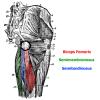Folders |
Regain the Frontal Plane
Published by
as I was working with a runner recently, she made a salient observation from her running career. Athletes are more durable and better performers than runners. Last week, I argued a few points for why I believe runners need more of a multi-lateral approach is that too often runners cease being athletes and at that point trouble arises. We know that asymmetries can lead to a great deal of dysfunctional issues from the ground up and that asymmetries of all kinds (postural, structural, strength, motor control, mobility, stability, etc) are problematic and can be used to identify individuals at risk of injury. Running alone feeds into the development of asymmetries of all kinds. Most notably, the runner spends a great deal (all) of his time moving though the sagittal plane with some movement in the transverse plane. Over time the runner loses his ability to control and operate in the frontal plane. This results in an imbalance in triplanar movement that can lead to a gamut of dysfunctional patterns including poor load transference through the LPH complex, the loss of multisegmental flexion, the loss of squatting ability, altered single leg stance, straight leg raise dysfunction, and reductions in hip rotation range of motion. To the runner this means more issues at the SI joint, pubic symphysis, the knee, lumbar spine, and groin (adduction related groin pain, “runners hernia,” athletic pubalgia, or labral impingement). In the Postrual Restoration Institute (PRI) approach, it seems (Disclosure: I am by no means a PRI expert) they follow a three step process that involves first utilizing exercises to restabilize the function of the body in the sagittal plane, developing strength and motor control in the frontal plane, and finally adding in a transverse plane component to appropriately and completely allow runners to regain their performance capacity. When looking at this through the lens of what we know about movement “subsystems” through the body we realize that loss of a runner’s ability to handle the frontal plane can lead to critical energy leaks. The lateral subsystem is an integral component consisting of the gluteus medius, minimus, and the contralateral adductors of the thigh. Diane Lee suggests that the TFL is a big player as well. These muscles provide the primary containment of the hip joint and also contribute a great deal of frontal plane stability of the pelvis and spine. As there is a mechanical relationship between frontal and transverse plane motion at the spine, a loss of stability in one leads to altered accessory movement, and as Sarhrmann warns, loss of optimal function. This energy leak can lead to decreased efficiency and also decreased force production leading to lower performance capacity. Addressing their function is of primary importance and doing so is difficult to do with running alone as these muscles do not serve a huge role in sagittal plane movement (they do, but to a minimal extent, and often as a result of inadequate function of the prime movers). If we are to truly be functional, successful athletes it is imperative to develop systems in which our runners are allowed to remember that they are athletes. Now please don’t get me wrong, I WANT RUNNERS TO RUN, I just don’t want them to ONLY run. Best regards, Carson Boddicker
|




